
Bangladesh, a beautiful small country in South Asia bordering with India and Myanmar is yet to be developed in tourism. Though there are many beautiful places here to visit, it is one of the least tourist destinations in the world. The people here are very friendly and hospitable. They welcome tourist everywhere and try to help them. To make a list of the best places in a country is always very hard and disputable. From my visiting experience in Bangladesh, I’ve created this list. So, here is a list of the 20 best places to visit in Bangladesh for you.
1. Cox’s Bazar:

Cox’s Bazaar is the tourist capital of Bangladesh. Sloping down to the blue water of the Bay of Bengal against the picturesque backdrop of a series of hills covered with dense forest, Cox’s Bazar sea beach is the longest sea beach in the world. Its total length is 120km. Located 150 km south of Chittagong, this place got its name from Captain Hiram Cox, an officer of the British East India Company. It is the place of miles of golden sands, lofty cliffs, surfing waves, amazing conch shells, beautiful pagodas, Buddhist temples and tribes, and mouthwatering seafood. The shark-free beach has its own reputation for bathing, sunbathing, swimming, and surfing. The breathtaking beauty of the setting sun behind the vast sea is fascinating. >>>Read More<<<
2.The Sundarbans:

A unique eco-tourism destination, the Sundarbans, is the largest Mangrove Forest on earth and a UNESCO World Heritage Site. It stretches about 80km into the Bangladeshi and Indian mainland from the coast of the Bay of Bengal. 60% of this mist-shrouded forest is located in Bangladesh. Though this 10,500km2 forest area is surrounded by two of the most densely populated country on three sides, it remains remote, inhospitable and largely uninhabited by people. Intersected by a complex network of rivers and creeks, mudflats and tiny islands, this amazing forest is comprised of two elementary ecoregions: The Mangrove Forest and the Freshwater Swamp Forest. The word Sundarbans means a beautiful forest. However, the name derived from the “Sundari” trees which are seen here plentifully. This forest is mainly famous for the Royal Bengal Tiger but you’ll also see here the spotted deer, saltwater crocodiles, and different types of birds. This huge forest provide habitat for 42 species of mammal, 290 species of bird, 120 species of fish, 50 species of reptiles and 8 species of amphibians
>>>Read More<<<
>>>Read More<<<
3. The St. Martin’s Island:

The St. Martin’s Island, also known as Narikel Jinjira (an island of coconut) and Parachinar Deep (an island of cinnamon), is one of the most visited tourist’s spots in Bangladesh. The only coral island in Bangladesh is about 8 km in length and rarely more than 1km wide. It is about 10 km (6mi) south-west of the southern tip of the Cox’s Bazar-Teknaf peninsula. Beaches fringed with coconut palms, panoramic beauty of the island and pristine marine life attract the tourists. Magnificent landscapes, crystal clear sea water, coral colony, and the roar of the Bay of Bengal are the main attraction of the visitors. Tourists come here to soak up sun rays and roaming in lonesome seclusion on the sea beach enclosed by corals and crystal clear water of the sea. Far from the noisy environment of the city life, the tranquility of this island will help you to pacify your soul. To enjoy sensing and sighting the beauties of darkness with no electric lights around the blurry vision encourage many tourists to stay here overnight. If you stay here overnight and enjoy one moonlit night here, you will want to stay on this island forever. Various types of seafood here will satisfy your appetite. >>>Read More<<<
4. Kuakata:

Known as Sagar Kannya or the Daughter of the sea, Kuakata is famous for its panoramic sea beach. This 18 km long and 3 km wide sea beach is located at Kalapara Police Station of Patuakhali district. It is about 320 km from Dhaka and 70 km from Patuakhali Sadar. It is a unique place where you can witness both sunrise and sunset unobstructed. This beach is a lovely combination of picturesque natural beauty, blue sky, sandy beach, vast bay, and evergreen jhaubon. Here one can see 100 years old Buddhist temple and two wells of about 200 years old. >>>Read More<<<
5. Jaflong:

Situated at the border between Bangladesh and Indian state Meghalaya, Jaflong is one of the most popular tourist destinations in Sylhet. Overshadowed by subtropical mountains and rain-forests, this place is about 60 km from Sylhet town. This scenic spot is situated on the river Piain. Its landscape beauty among gardens and hills enchants the tourists. The Mari River coming from the Himalayan Mountain range brings tons of stone boulders with its stream. This place is famous for its stone collection activities. It is the home of the Khasi tribe. Tourists come here mainly in winter to see the stone collecting process but during monsoon, Jaflong reveals its different type of beauty with numerous falls cascading from lush green mountains. The amazing beauty of white clouds and gushing waterfalls streaming from the green mountains enthrall locals as well as tourists. >>>Read More<<<
6. Sajek Valley:
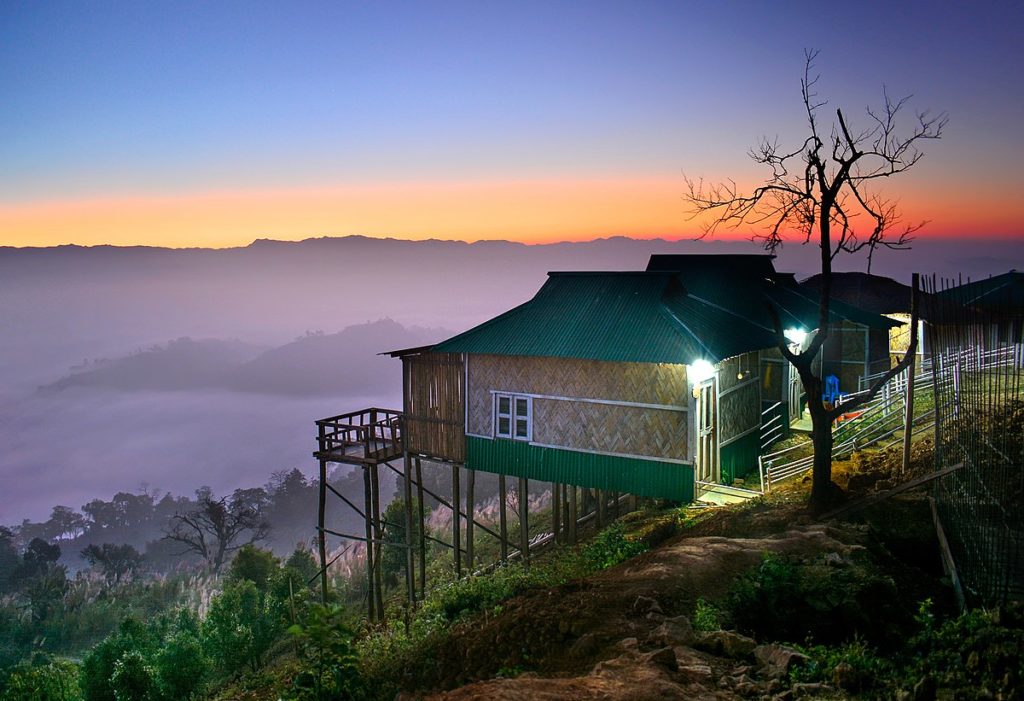
Sajek Valley is one of the topmost tourist destinations in Bangladesh. Located among the hills of the Kasalong range of Baghaichhari Upazila in the Rangamai District, this place is about 1800 feet above the sea level. It is known as the queen of hills and roof of Rangamati. Sajek valley is 80 km away from Khagrachari town and 90 km northwest from Rangamati town. It is only 8 km away from Mizoram, India. It’s lush green, scenic beauty of hills, wilderness, the opportunity of playing with clouds attract the tourists to come here. To enjoy its natural beauty every day thousands of the tourists come here. No word is enough to define the beauty of Sajek Valley. The deep forest, grassland, hilly areas make it a wonderful tourist spot and one of the best choices among the traveler, adventure lover and digital nomads. At the peak of the valley, you will see the passing clouds around you even you can touch them. This picturesque beauty will make you feel the view of heaven on earth. The curvy hilly roads, small rivers among the hills make this place thrilling. The weather of Sajek changes frequently. >>>Read More<<<
7. The Shat Gambuj Mosque:
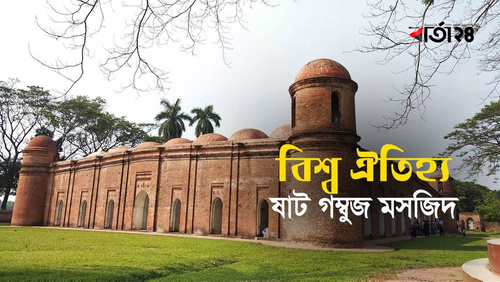
The Shat Gambuj Mosque is a UNESCO World Heritage Site and one of the topmost tourist attractions in Bangladesh. It is one of the largest historical mosques of the Sultanate period. The great Ulugh Khan Jahan established this mosque three miles west of the present Bagerhat town. This serene and imposing monument stands on the eastern back of an enormous sweet-water-tank. The mosque is famous for its sheer size and architectural beauty. The archaeological elegance of it enthralls the tourists even now. The simple look of this aristocratic structure with its absolute plainness but solid shape reflects the potency and simplicity of its designer. Besides using it as a prayer hall, Ulugh Khan Jahan used the mosque as his assembly hall. Beside this mosque, there is an archaeological museum where you can find different archaeological and historical materials of that time. >>>Read More<<<
8. Paharpur:

Sompur Mahabihar or Paharpur Bihar is one of the largest well known Buddhist Bihar's in the Indian Subcontinent and one of the most popular tourist destinations in the country. This very important archaeological site was designated as a UNESCO World Heritage Site in 1985. The Bihar is located at Paharpur village, Badalgachhi Upazila in Naogaon District. This Buddhist Monastery is famous for its unparalleled architectural design. The wonderful terracotta plaques of the then musicians, snake charmers, different types of animals are the key attractions to see. The outer walls of the temple are decorated with the lifestyle plaques of ordinary folks of hundreds of years. >>>Read More<<<
9. National Memorial:
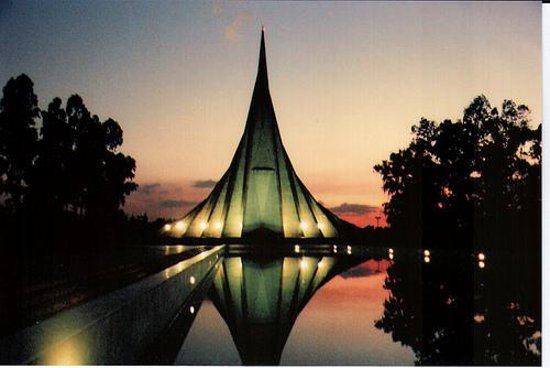
National Martyrs Memorial or Jatiyo Sriti Shoudho is the national monument of Bangladesh, erected as an iconic structure in the memory of those valiant sons and daughters who laid down their lives in the Liberation war of 1971. This monument is situated at Savar, about 35km northwest of Dhaka. Architect Moinul Hossain designed the monument. The whole complex area is of about 84 acres which are surrounded by a green belt of about 24.7 acres. Some mass graves and a water body is located in front of the monument. From the main entrance, visitors get a strong axial view of this structure. To reach to it one has to cross jagged and uneven path and a manmade lake by a bridge that symbolizes the nation’s difficult path to independence and the troublesome journey lies ahead. Visitors can watch this monument from different perspectives and one can enjoy its dramatically differing configurations depending on the viewing location. From the front, the monument appears to be a single structure but in reality, it is composed of seven standing isosceles triangular concrete plates. Each of these plates varies in size and height from others. The highest plate has a smaller base and the broadest base has the lowest height. These plates are folded in the center at a 90 -degree angle and this unique configuration help this structure to change its configuration when viewed from different angles. This wonderful structure tells the story of a nation’s journey to independence. For its amazingly choreographed architecture, it is considered to be one of the finest monuments in the world.
10. Sonargaon:

Sonargaon or The village of gold was the old capital of Bengal in the medieval period. It was a significant administrative and business center at that time. During the medieval period, it was the mint capital. From the 13th century, Sonargaon was used as the capital city by different rulers of eastern Bengal. In the mid-13th century, it was the capital of the Hindu Deva dynasty. But after a short time, Muslim rulers acquired it and made it their capital city. First, it was ruled by independent rulers and then it became a subsidiary capital of the Bengal Sultanate and then Delhi Sultanate. Then it was acquired by the Mughals. It lost its pride of being the capital in 1610 when the Mughals shifted the capital of Bengal to Jahangirnagar which was later named Dhaka. During the British period, wealthy Hindu merchants settled a new neighborhood named Panam city near Sonargaon. Most of the Hindu and Mughal structures are ruined but some of the structures built in the British period are still present today. Very little trace of the original capital now remains in Sonargaon. Now, most of the tourists visit Sonargaon to see Panam Nagar, A decaying street with some decayed edifices by wealthy Hindu merchants and Sardar Bari a beautifully renovated king’s palace with a gorgeous pond and amazing folk-art museum.
11. Ahsan Manzil:
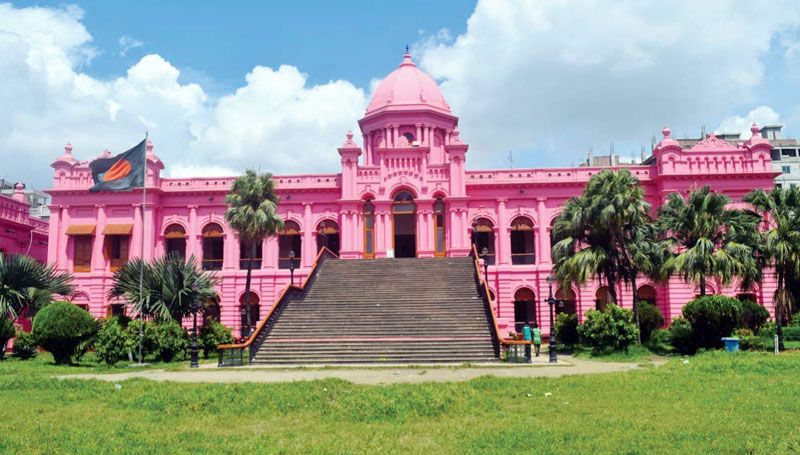
Once the official residential palace of the Nawabs of Dhaka, now Ahsan Manzil or the Pink Palace is a museum and one of the most visited places in Dhaka. The 5.5-acre premise of this palace bears the significance as an architectural reminder of the elite life of the Nawabs of Dhaka during the colonial era of 19th and early 20th century. In 1872, the patriarch of the Nawab family, Abdul Ghani (1813-1896), constructed the family’s official residence on the bank of the River Buriganga in old Dhaka and named the palace after his son Nawab Khwaja Ahsanullah (1846-1901). It’s mostly European styled building mixed with some decorative Indian motifs. Its soaring dome appears to be more about impressing the viewer on the exterior, rather than within the interior. Many important persons of the Colonial period either visited or stayed here. Viceroy Lord Nathaniel Carson was one of them. He stayed here as a guest of Nawab Salimullah Bahadur in 1904. In 1906 Muslim leaders from all over India congregated at the Durbar Hall of Ahsan Manzil for the 20th Session of the All India Mohammedan Educational Conference in Dhaka. In the same year here the All India Muslim League was formed that later lead the creation of Pakistan-when the British left the Indian subcontinent in 1947. 16 years after its erection, it was damaged by a cyclone. After its reconstruction, the palace became grander than before. After the death of the Nawab and his son, the family fortune was dispersed and the palace eventually fell into disrepair. As the influence and the prestige of the Nawabs declined in the 20th century and the descendants of the Nawabs became too poor to look after such a vast property, The then Government took over this palace in 1952. However, the poor descendants of the Nawab family and the poor local people continued to hold the palace until the 1970s. They inflicted much harm to the building by indiscriminately altering its configuration. In 1985 the Government of Bangladesh acquired the property and after much deliberation decided to convert it into a national museum. The preservation work completed in 1989 and Ahsan Manzil started its journey as a museum in 1992.
12. Lalbag Fort:
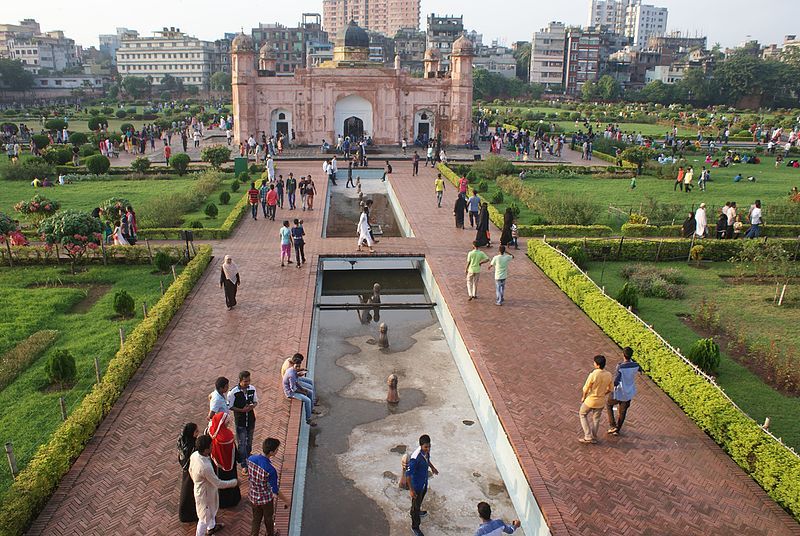
This 17th -century incomplete Mughal fort is the most popular and renowned one and bears a great significance of art by the Mughal Empire in Bangladesh. It stands proudly before the Buriganga River in the southwestern part of the old city. In 1678 a Mughal prince Muhammad Azam started the fort’s construction work during his viceroyalty in Bangladesh. But the construction work remained incomplete when he was called back by his father Aurangazeb to the capital Delhi. His son Shaista Khan did not complete the fort though he stayed here up to 1688. In 1684 his daughter Pari Bibi died. After her death, he started thinking the fort ominous and left the structure incomplete. There are several structures in the fort area.
13. Dhakeshwari National Temple :
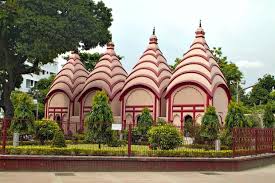
Dhakeshwari Temple is a state-owned Hindu temple in Dhaka. The name Dhakeshwari means “Goddess of Dhaka”. This ‘National Temple’ was built by one Mangat Ray who was also known as Ballena, younger brother of Arakanese king Shrisudharma, son of famous Arakanese king Raja Malhana, alias Husen Shah. Though the present edifice is modern in construction, there has been a temple on this same spot for nine centuries. The original statue was 800 years old but it was vandalized by the Pakistani soldiers during the liberation war in 1971. As the temple complex has undergone repairs, renovation and rebuilding several times in its long years of existence, its present condition does not clearly indicate any of its original architectural sign.
There are four same sized tiny temples standing one after another from east to west. Facing south the main temple is to the north of the nat-mandir. The main temple is a three-roomed structure. The temple remains open every day and spectators can enter inside. It remains closed only in the afternoon from 02.00 pm to 04.00 pm. As it’s a sacred place for Hindus, leave your shoes outside at the time of entering the temple. Do not touch anyone or anything belongs to the temple. Every year in September, the temple and its surrounding areas become crowded with thousands of devotees for Durga Puja. Especially that’s the time to visit here to have a colorful and joyful time to spend.
14. National Parliament House:
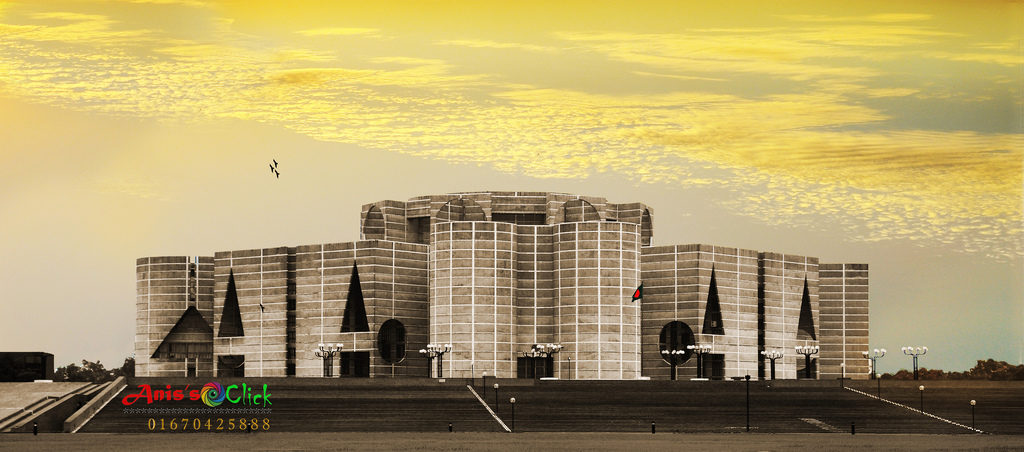
Designed by famous architect Louis I Kahn, the National Parliament house of Bangladesh is one of the twentieth century’s most significant buildings. Located at Sher-e Bangla Nagar, this building is the largest legislative complex in the world. The construction work of Bangladesh National Parliament commenced in 1964 but halted due to the liberation war and it was finally completed in 1982. The total complex is divided into three parts: The Main Plaza, the South Plaza, and the Presidential Plaza. The main building is in the middle of the complex. The MP hostel is located at the outer part of the complex. A beautifully designed artificial lake surrounds the main building. The North of complex, across the Lake Road, has intricately designed lake called Crescent Lake and there is a monument of late president Ziaur Rahman. The two complexes together attract the attention of the tourists. The complex is very popular among joggers and skaters.
15. National Zoo:
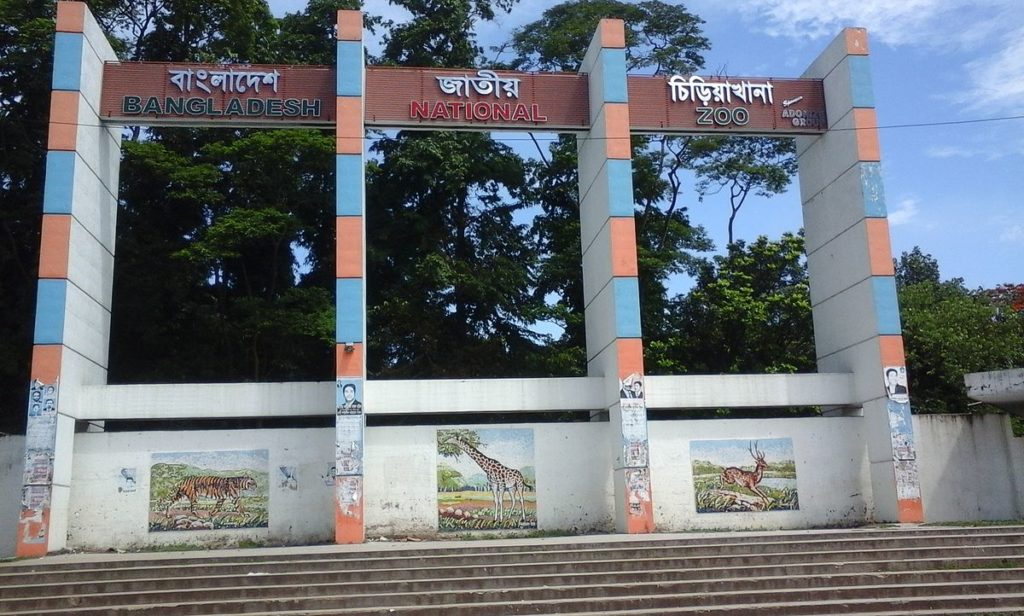
Located at Mirpur in Dhaka, Bangladesh National Zoo is one of the key attractions among the tourists and the local people. The zoo houses more than 2,000 animals of 165 species. It was established in 1974 over 75.53 hectors of land. About 10,000 spectators visit The National Zoo daily and the number increases in the weekends and holidays. Among the animals, the key attraction is the Royal Bengal Tiger. It has a good collection of birds, animals, and wildlife of both local and foreign origin. There are different types of animals including Lions, elephants, cheetahs, rhinos, zebras, deer, giraffes, black bear, hippos as well as many species of monkeys, chimpanzees, baboons etc. There are several bird shades in the zoo. Here you will find different types of local and foreign birds.
16. National Botanical Garden:
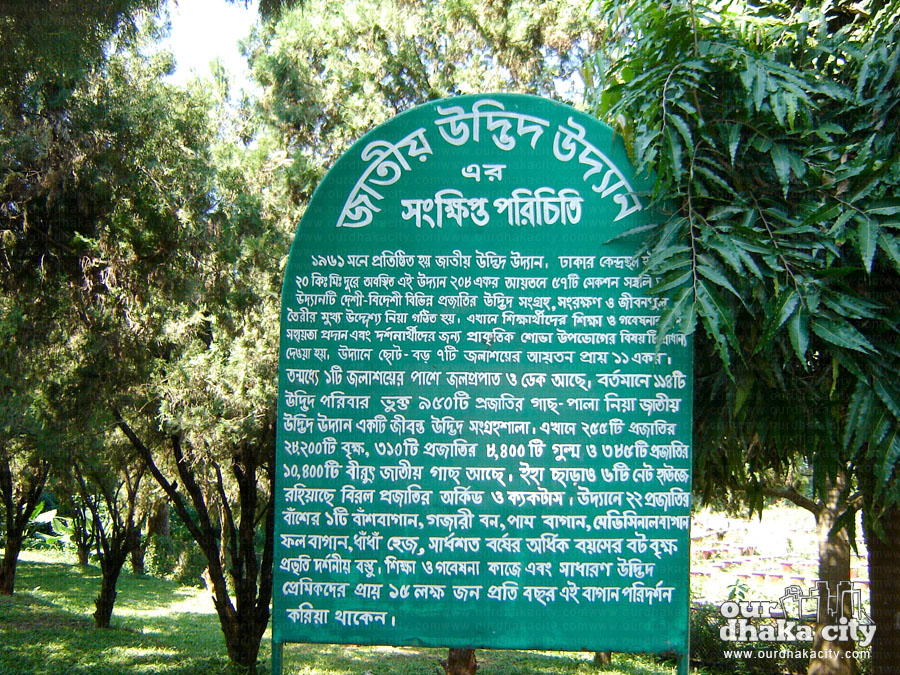
Situated at Mirpur in Dhaka beside the Dhaka Zoo, The National Botanical Garden is the largest plant conservation center in Bangladesh. Established in 1961 over an area of about 84 hectors it is a must visiting place for nature lovers and botanists. Divided into 57 sections, this place has a collection of approximately 100 species of local and foreign plants. Hundreds of varieties of roses, multiple types of bamboo in the bamboo groves, the sandalwood, and old banyan trees are the key attractions. There is a cactus house, lily ponds, six lakes, two nurseries, an orchid house, a tissue culture research center, and a lotus pond with extensive visitor facilities.
17. Star Mosque:
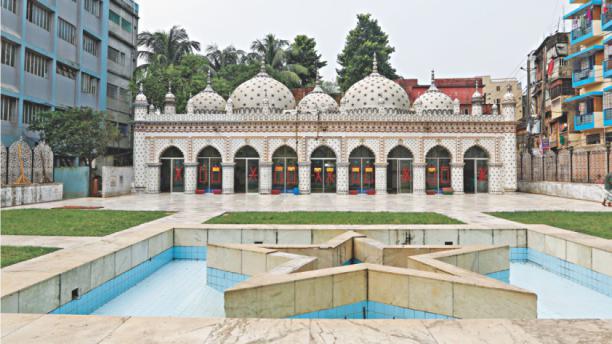
Located at Armanitola in old Dhaka, decorated with engraved floral and star patterns, Star mosque or Tara Masjid is one of the most famous tourist attractions in Bangladesh. It has ornate designs and it is decorated with motifs of blue stars. This beautiful building was built in the first half of the 19th century by Mirza Golam Pir. Unlike other Mughal architectures, there is no inscription found in the mosque mentioning its founding year. According to some people, this mosque was built in 1711. Tara Mosque is one of the few edifices in this subcontinent which has such expanded special type of china clay mosaic works, traditionally called Chini Tikri. At first, it was a small three domed mosque. Its walls were not decorated. In 1926, Ali Jaan Bepari, a wealthy merchant at Armanitola residential area wanted to renovate the mosque. He imported china clay tiles from Japan and England and decorated the entire mosque walls and even domes with nice floral and star-shaped patterns of China clay tiles. In the white marble background, the glistening engraved stars and floral patterns create an enchanting and serene environment of light and shade in the mosque as they mirror sunlight in different angles. During this renovation work, the artisans carefully preserved the original design of the mosque and only ornamented the existing structure. All over the mosque, the motif of stars is decorated and so the mosque got its name, the Star Mosque. In 1987, in the name of beautification of this archaeological site, the then government’s archaeological department extended the prayer hall and included two more domes, damaging its original historic structure. After all these the Star Mosque is a magnificent piece of work. Even the local residents of the area often stop for a while to have a look and be amazed at its perpetual beauty.
18. Kantaji Temple:
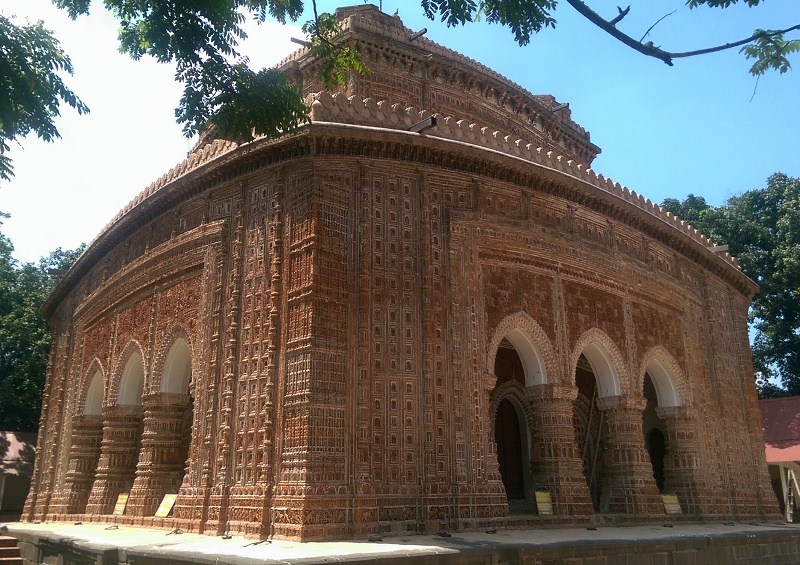
Kantaji Temple is a late-medieval Hindu temple at Kantanagar, Dinajpur. This temple is one of the best examples of the 18th century’s stunning religious edifices. It belongs to Hindu God Krishna and so it’s most popular among the devotees of Krishna in Bengal. Maharaja Pran Nath built this magnificent temple and devoted it to Krishna and his wife Rukmini. The construction work of this beautiful structure started in 1704CE and completed in 1722 CE. Its wall surfaces, both inside and outside are ornamented with figured and floral terracotta art. The stories from Mahabharata and Ramayana, the exploits of Krishna and a series of absolutely fascinating contemporary social scenes are depicted on the wall through the terracotta art.
19. Mahasthangarh:

Mahasthangarh is the most ancient city of Bangladesh. The word Mahasthan means a place with holiness and Garh means fort. The massive remains of Mahasthangarh represent a majestic past of about two thousand and five hundred years of Pundranagar, the capital of ancient Pundra Vardhan. This place is located 13 km north of Bogra town. Once, this rich city was fortified by brick walls. This one of the highest areas of Bangladesh is about 36 meters above sea level. The fortified city is rectangular in plan and it’s 1,525 meters long from north-south and 1,370 meters broad from east-west and 5 meters high from the surroundings. From a script discovered in 1931, it is known that this city existed during the 3rdcentury BC. This area was in use until the 18th century AD.
20. Ratargul Swamp Forest:
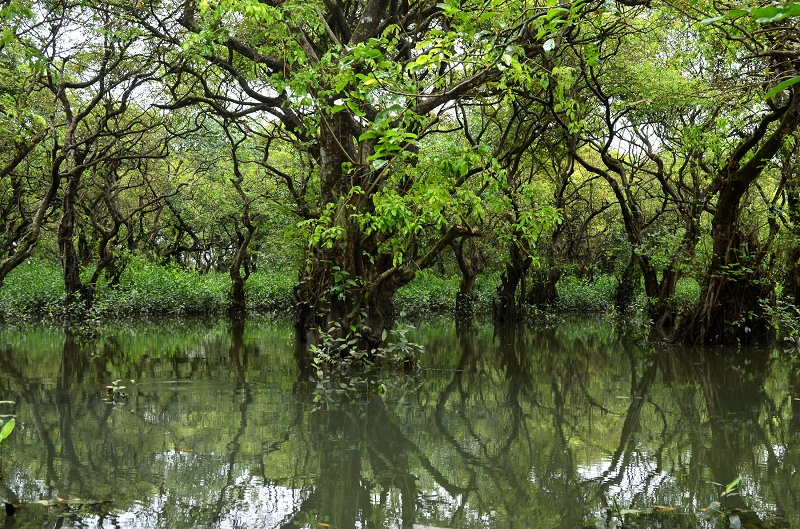
Located in Gowan River, Gowainghat, Sylhet Ratargul Swamp Forest is the only freshwater swamp forest in Bangladesh and one of the few in the world. It is called the Amazon of Bangladesh. The beauty of this evergreen forest blooms mainly in the rainy season. This forest is flooded by the water coming from the hills of India during monsoon. In other seasons it remains dry. The water of this forest is transparent and you can see the bottom layer of this forest through this water. Here, the water-level depends on the quantity of rainfall. It could be 15-20 feet if the rainfall is high. The total area of this swamp forest is 3,325 acres. The main trees of this forest are Koroch and Hizal. Monkeys, snakes, frogs and many types of birds are seen in this forest. The best time to visit Ratargul is Monsoon. You can hire a local wooden boat and enjoy the stunning beauty of this forest the whole day.
No comments:
Post a Comment